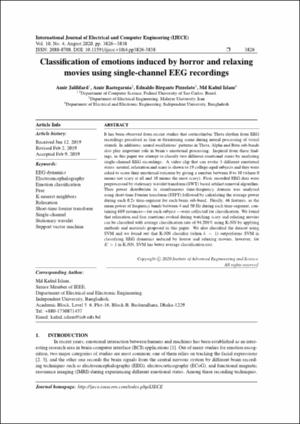| dc.contributor.author | Amir, Jalilifard | |
| dc.contributor.author | Amir, Rastegarnia | |
| dc.contributor.author | Ednaldo Birgante, Pizzolato | |
| dc.contributor.author | Md Kafiul, Islam | |
| dc.date.accessioned | 2020-03-07T11:51:03Z | |
| dc.date.available | 2020-03-07T11:51:03Z | |
| dc.date.issued | 2020-08 | |
| dc.identifier.issn | 2088-8708 | |
| dc.identifier.uri | http://ar.iub.edu.bd/handle/11348/463 | |
| dc.description.abstract | It has been observed from recent studies that corticolimbic Theta rhythm from EEG recordings perceived as fear or threatening scene during neural processing of visual stimuli. In additions, neural oscillations’ patterns in Theta, Alpha and Beta sub-bands also play important role in brain’s emotional processing. Inspired from these findings, in this paper we attempt to classify two different emotional states by analyzing single-channel EEG recordings. A video clip that can evoke 3 different emotional states: neutral, relaxation and scary is shown to 19 college-aged subjects and they were asked to score their emotional outcome by giving a number between 0 to 10 (where 0 means not scary at all and 10 means the most scary). First, recorded EEG data were preprocessed by stationary wavelet transform (SWT) based artifact removal algorithm.Then power distribution in simultaneous time-frequency domain was analyzed using short-time Fourier transform (STFT) followed by calculating the average power during each 0.2s time-segment for each brain sub-band. Finally, 46 features, as the mean power of frequency bands between 4 and 50 Hz during each time-segment, containing 689 instances—for each subject —were collected for classification. We found that relaxation and fear emotions evoked during watching scary and relaxing movies can be classified with average classification rate of 94.208% using K-NN by applying methods and materials proposed in this paper. We also classified the dataset using SVM and we found out that K-NN classifier (whenk= 1) outperforms SVM in classifying EEG dynamics induced by horror and relaxing movies, however, for K >1 in K-NN, SVM has better average classification rate. | en_US |
| dc.language.iso | en_US | en_US |
| dc.publisher | Institute of Advanced Engineering and Science (IAES) | en_US |
| dc.relation.ispartofseries | International Journal of Electrical and Computer Engineering (IJECE);Vol. 10, No. 4 | |
| dc.subject | EEG dynamics | en_US |
| dc.subject | Electroencephalography | en_US |
| dc.subject | Emotion classification | en_US |
| dc.subject | K-nearest neighbors | en_US |
| dc.subject | Short-time fourier transform | en_US |
| dc.subject | Stationary wavelet transform | en_US |
| dc.subject | Support vector machine | en_US |
| dc.title | Classification of Emotions Induced by Horror and Relaxing Movies Using Single-Channel EEG Recordings | en_US |
| dc.type | Article | en_US |
